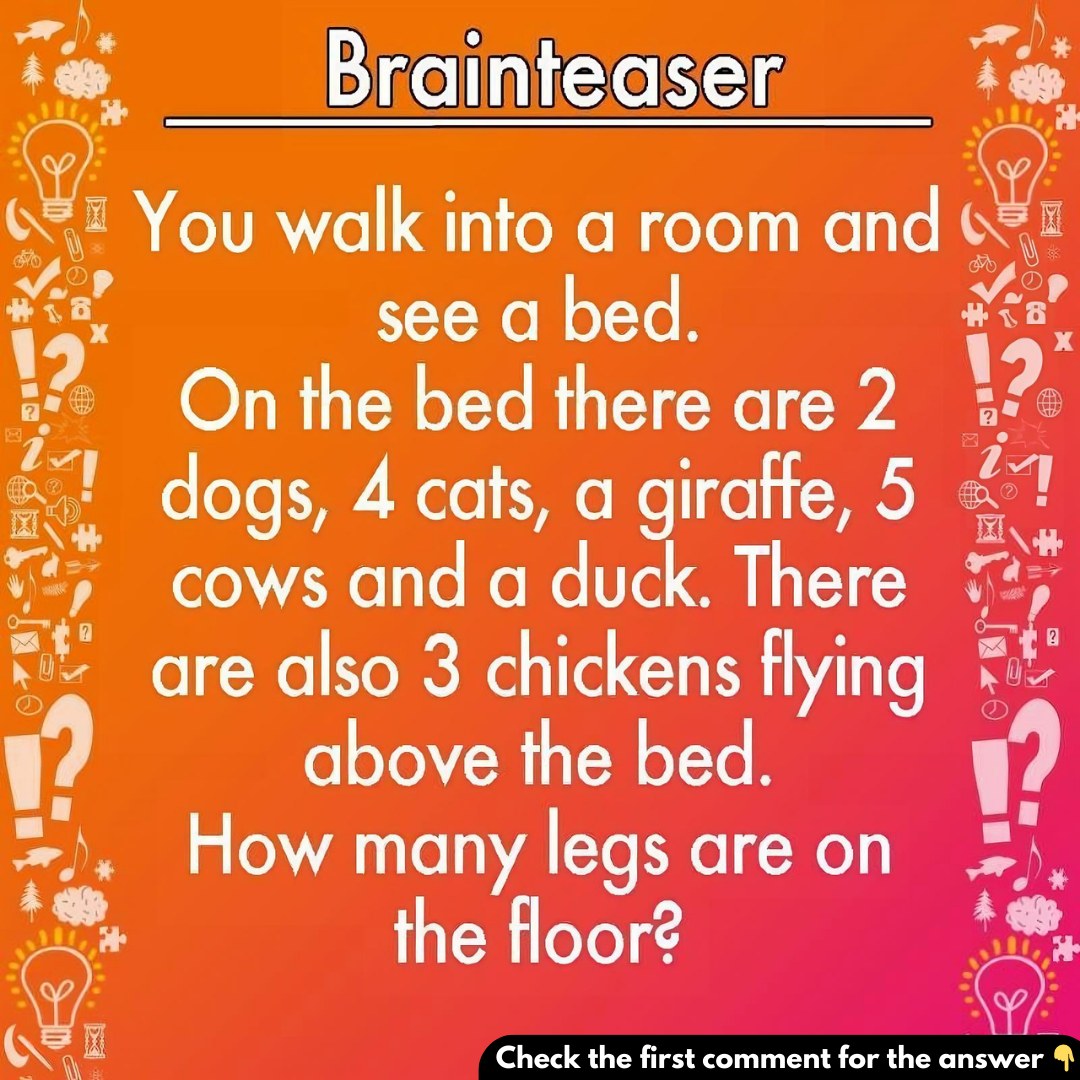Riddles are a fun and challenging way to exercise your mind, boost your problem-solving skills, and let’s face it, they can be pretty entertaining! They may seem simple at first glance, but often, the answer is not what you initially think. Today, we’ve got a brain teaser that might just leave you stumped.

Here’s the riddle: “You walk into a room and see a bed. On the bed, there are 2 dogs, 4 cats, a giraffe, 5 cows, and a duck. There are also 3 chickens flying above the bed. How many legs are on the floor?”
At first, it seems like a straightforward question. All you need to do is add up the legs of all the animals, right? Not so fast—this riddle is trickier than it appears. Let’s break it down step by step and figure out the real answer.
The Common Mistake: Counting the Animal Legs
The natural instinct is to start counting the legs of the animals listed—2 dogs, 4 cats, a giraffe, 5 cows, and a duck. However, this approach misses a key detail: all these animals are on the bed, not the floor. And the riddle specifically asks for the number of legs on the floor. This distinction is crucial.
The Chickens: A Clever Distraction
Another element that confuses many people is the mention of the 3 chickens flying above the bed. Some might wonder if their legs should be counted. The answer is no, because the riddle only cares about legs on the floor, and since the chickens are flying, they don’t contribute to the count. The chickens are there to distract you, not to help solve the riddle.
Breaking Down the Riddle: Step by Step
Let’s go through the riddle carefully and figure out how many legs are actually on the floor.
1. You Walk Into a Room
The first thing the riddle tells us is that you, the person, walk into a room. As a human, you have two legs, so we can start by counting your legs. That gives us 2 legs so far.
2. You See a Bed
Next, the riddle tells us there’s a bed in the room. Most beds have four legs unless it’s a special kind of bed, but there’s no indication here that it’s floating or missing legs. So, we can safely add the four legs of the bed to our count. Now, we’re up to 6 legs (2 from you and 4 from the bed).
3. The Animals on the Bed
Now comes the tricky part. The riddle lists several animals—2 dogs, 4 cats, a giraffe, 5 cows, and a duck—but all of them are on the bed. Since they aren’t on the floor, none of their legs count toward the answer. This is where most people get tripped up because they instinctively want to count the animals’ legs, but those legs aren’t on the floor.
4. The Flying Chickens
The riddle also mentions 3 chickens flying above the bed. Again, since the chickens aren’t on the floor, their legs don’t count. It’s just another detail designed to throw you off from finding the real answer.
The Final Answer: How Many Legs Are on the Floor?
When you strip away all the distractions—the animals on the bed and the chickens flying above—you’re left with just two things: you and the bed. You have two legs, and the bed has four legs. Therefore, the total number of legs on the floor is 6.
Why This Riddle Confuses So Many People
This riddle is a classic example of how easily we can get distracted by irrelevant details. It throws a list of animals at you and creates the illusion of complexity, making you think you need to count all their legs. But in reality, the animals don’t contribute to the final answer since none of them are on the floor.
The riddle is designed to make you overthink. People often get so caught up in counting the animals’ legs that they forget to focus on the specific question: how many legs are on the floor? The key to solving it lies in ignoring the distractions and focusing on what the riddle is actually asking.
Conclusion: Simplicity is Key
In the end, the answer to this riddle was simple: 6 legs on the floor—yours and the bed’s. However, the clever wording and extra details led many people to overcomplicate the solution. That’s what makes riddles so enjoyable—they challenge us to think critically, question our assumptions, and focus on the actual problem.
So, did this riddle catch you off guard? If it did, don’t worry! The fun of riddles is in the mental challenge they present. Keep practicing with more riddles, and who knows, the next brain teaser might be a little easier to crack.





